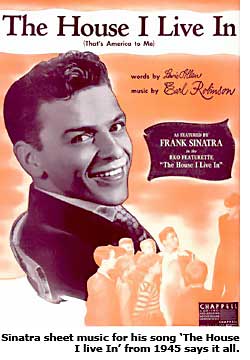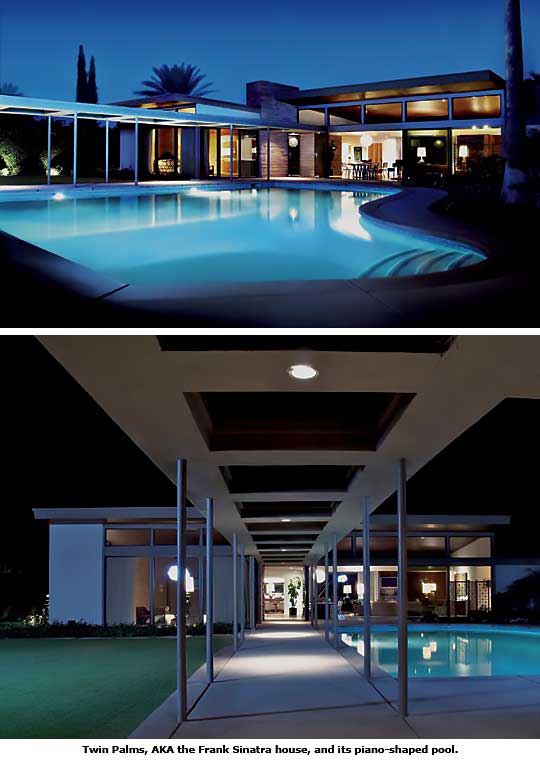One Voice, Twin Palms - Palm Springs

He had a voice that caressed, and caressed slowly. He could swing like mad, but he never rocked. Frank Sinatra—'the Voice,' the 1950s' greatest crooner, perhaps the greatest ever—was made for Palm Springs, a town that's all about relaxing with style. Or was Palm Springs made for Frank?
Twin Palms, Frank Sinatra's first house in the desert, became a Palm Springs landmark as soon as it was completed, Christmas 1947—but not because it was big or spectacular.
For a house of a star, the four-bedroom, 3,500-square-foot house was modest, even as a weekend home. It is, in essence, a typical postwar ranch-style house, albeit more elegant and modern than most. It is also an architecturally important house as the first home designed by E. Stewart Williams, who would go on to become one of Palm Springs' most important architects.
But what made the Sinatra house an instant landmark was the way it made use of its location, at the eastern edge of what was then a very small city, far from any other houses. A pair of Washingtonia palms alongside the pool dominated the landscape. From the air they could be spotted for miles.
"Those are the most famous palm trees in Palm Springs," says Allen Miller, longtime Palm Springs real estate broker and modern fan who represents the home's current owners. Looking for a pad while visiting town? You can rent Sinatra's former digs if you're willing to part with, say, $1,800 a night. "It's a pretty pricey rental," Miller admits.
Starting with a Christmas party that first year—the house was constructed using round-the-clock shifts to ensure it would be ready in time—pilots would aim for the twin palms, and deposit such guests as Bogie and Bacall, Phil Silvers, Peter Lawford, and Sammy Davis, Jr.

Also by the pool stands a tall flagpole. When the flag was raised, friends in town knew they could motor out and join Frank and guests around the famous piano-shaped pool. When the flag was down they waited for it to go up.
It's not surprising that Sinatra, with his relaxed delivery, precise diction, perfect timing, and impeccable swing, should have fallen in love with desert modernism as well as with the desert. As Miller notes of Frank, "He had really good taste. He was a sharp dresser. The guy had style, no question about it."

But Sinatra wasn't a committed modernist. He asked for a design in the Georgian style. Williams did as asked—but also showed him a modern design, which Williams favored. So did Frank, according to Palm Springs architectural historian Robert Imber, who heard this oft-told tale from Williams himself.
The house is perfect for parties, with a living area that opens through sliding doors onto pool and patio, with cabana and guest quarters beyond.
To get a sense of this scene during its heyday, watch 'The Damned Don't Cry,' a 1950 film noir in which Joan Crawford as a gal with more ambition than morals takes up with a gangster in the town of 'Desert Springs'—and takes several dives into what the gangster brags is "the best-looking swimming pool in the west."
Of course it is. It's the Sinatra pool. "The house," architectural historian Tony Merchell says, "is all about the pool."
Williams provided some charming touches, including a sky-lighted canopy that stretches alongside the pool, and a broad soffit that hovers beneath the ceiling in much of the living area, providing an absorbing play of space, a sense of intimacy—and marvelous, soft light effects as it absorbs the sunlight that pours in through clerestory windows.
The house, not surprisingly, has become legendary—and not because of its architecture. Visitors are often shown a chipped sink, reportedly damaged when Frank tossed a bottle during a battle with Ava Gardner. Twin Palms was "the only house we ever really could call our own," Gardner wrote in her memoirs. It was also, she wrote, "the site of probably the most spectacular fight of our young married life—and honey, don't think I don't know that's really saying something."
Sinatra, it must be recalled, was a young man in 1947—32 years old—and some thought a has-been. It was only nine years since Sinatra was earning $15 a week as a singing waiter in a New Jersey roadhouse, and three years after Walter Winchell pegged him as the highest paid person—that's person, not performer—in the world.




